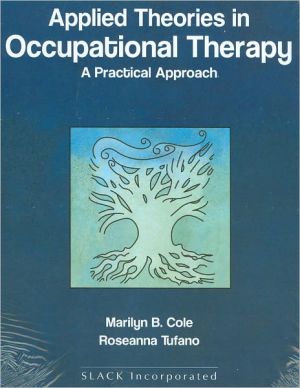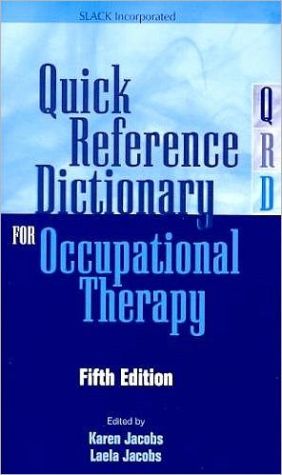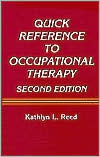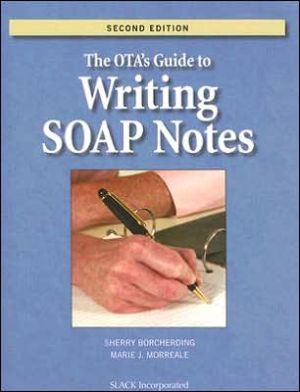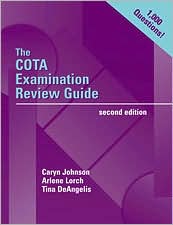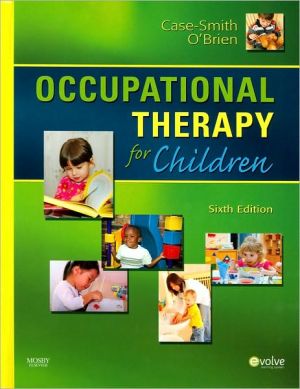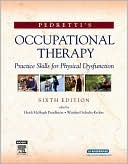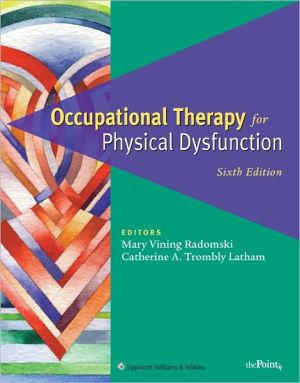Applied Theories in Occupational Therapy: A Practical Approach
Applied Theories in Occupational Therapy: A Practical Approach provides a comprehensive overview of theories and frames of reference in occupational therapy. Unlike other texts, there are no distinctions between specialty areas as current and developing theories are applied to a continuum of health and wellness for all age groups. Practical guidelines are included to assist with evaluation and treatment planning. The focus of this text is wellness rather than illness. Applications and...
Search in google:
Applied Theories in Occupational Therapy: A Practical Approach provides a comprehensive overview of theories and frames of reference in occupational therapy. Unlike other texts, there are no distinctions between specialty areas, as current and developing theories are applied to a continuum of health and wellness for all populations across the lifespan. Practical guidelines are included to assist with evaluation and intervention strategies. Marilyn B. Cole and Roseanna Tufano examine the different levels of theory, the definition of each, and the various ways in which these levels guide occupational therapy practice. This timely text is divided into three sections: foundational theories that underlie occupational therapy practice, occupation-based models, and frames of reference. Students and practitioners are provided with specific guidelines as well as case examples and learning exercises to enhance their understanding of applied theory. The first section summarizes the overarching theories that influence the practice of occupational therapy while incorporating the Occupational Therapy Practice Framework. These theories are discussed in a step-by-step format as they are related to occupational therapy. The second section reviews five currently used occupation-based models, providing readers with a description of each model according to Mosey’s organization structure. At the end of this section is an integrative case example intended to assist with the clinical integration of these models. The third section reviews and applies nine frames of reference most commonly used in occupational therapy practice today. Using the structured outline, students and practitioners can easily compare one frame of reference with another as part of the clinical reasoning response. Topics Covered: • Evolution and history of occupational therapy theory • Proposed taxonomy of occupational therapy models and frames of reference • Understanding systems and contexts • Using different levels of theory • The role of occupational therapy in health and well being Features: • Content analysis of 20 years of Slagle Lectures • U.S. and International models of health care • A review of systems theory as a perspective of occupational therapy practice • An organizational structure and template to formulate the components of each model and frame of reference Applied Theories in Occupational Therapy follows the belief that theory guides practice. This text provides practitioners with an excellent repertoire of theories to apply to occupational therapy practice. It is the ideal resource for students and practicing therapists who are looking to further their understanding of applied theory.
CONTENTS Dedications About the Authors Preface SECTION I: APPLIED THEORIES OF HEALTH AND WELLNESS Chapter 1. Occupational Therapy’s Broadening Horizons • Eight Major Trends • The Evolution of Occupational Therapy • Paradigm Shifts in 20th Century Occupational Therapy • Theoretical History of Occupational Therapy • Learning Activities Chapter 2. Applied Models of Health Care in Occupational Therapy • Medical Model • Client-Centered Model • International Classification of Functioning Model • American Occupational Therapy Practice Framework • Learning Activities Chapter 3. Applied Systems Theory in Occupational Therapy • General Systems Theory • Holism • Core Concepts of Systems Theory • Five Components of Systems Thinking: An Illustration • Hierarchy Versus Heterarchy • Impact of General Systems Theory • Contexts as Subjective Systems • Learning Activities Chapter 4. Theory Organization in Occupational Therapy • What Is Theory? • Levels of Theory • Paradigm • Occupation-Based Models • Frames of Reference • How to Evaluate Models and Frames of Reference • Learning Activities Chapter 5. Applied Models of Community Health and Well-Being • Occupational Therapy Practice Comes Full Circle • Occupation, Health, and Well-Being • Public Health and Occupational Therapy • Health Promotion and Occupational Therapy • United States Health Delivery System: A Mini Comparison • Healthy People 2010: Goals and Objectives for the United States • Determinants of Health • Health Promotion Models for Community-Based Practice • Learning Activities SECTION II: OCCUPATION-BASED MODELS Chapter 6. Occupational Behavior Chapter 7. Model of Human Occupation Chapter 8. Occupational Adaptation Chapter 9. Ecology of Human Performance Chapter 10. Person–Environment–Occupational–Performance Model Chapter 11. Model Integration SECTION III: FRAMES OF REFERENCE Chapter 12. Applied Behavioral Frames Chapter 13. Cognitive Behavioral Frames Chapter 14. Biomechanical and Rehabilitative Frames Chapter 15. Toglia’s Dynamic Interactional Approach Chapter 16. Allen’s Cognitive Levels Frame Chapter 17. Lifespan Development Frames Chapter 18. Sensory Integration and Processing Chapter 19. Motor Control and Motor Learning Frames Chapter 20. Psychodynamic Frame Chapter 21. Frames of Reference Integration Index
